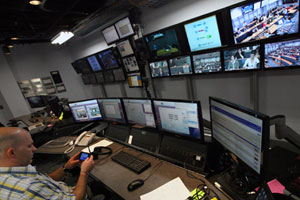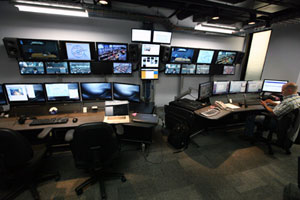 |
| David Miller keeps an eye on the monitors in the control room.(Bruce Bottomley Photo) |
Old school:
A student has a question. He or she raises their hand and waits patiently for the lecturer to notice or to finish their point. Once invited to speak, the question is shouted to the front of the room.
New school:
A student has a question and presses a button at their desk, lighting up that spot on a digital map of the classroom that the lecturer can see on a touchscreen monitor. He or she can see how many students have questions, and in what order they entered the cue. With the touch of a button, a microphone is activated at the student’s desk, lighting up in solid blue to let the student know, and a high-definition camera automatically zooms in, allowing students in another classroom an entire province away to see and hear the question and response.
Welcome to the new classroom experience for first-year ±«Óătv undergraduate medical students, both at Carleton campus in Halifax and ±«Óătv Medicine New Brunswick in Saint John. To help facilitate a teaching environment that spans the Bay of Fundy, lecture halls and meeting rooms in both locations have been wired with state-of-the-art video conferencing technology. The system of cameras, microphones and viewscreens may seem futuristic at first glance, but they’re designed to make a distributed medical education program work almost as seamlessly as one delivered in the same room.
“We have to provide the students with a comparable learning experience,” explains John Robertson, director of Academic Computing Services and MedIT. “That means they have the same access to the lecture materials and the professor. They have to interact.”
 |
| Located in the Tupper Link behind the classrooms, the control room resembles a television studio. (Bruce Bottomley Photo) |
Watching a lecture in action from the control room—which, with 20-plus monitors, feels not unlike sitting backstage at a television studio—you see what he’s talking about. Three large projector screens sit high above the lecturer for all in the classroom to see: one showing the lecturer, one showing his or her PowerPoint presentation and one showing the classroom of the other location, Saint John or Halifax. There’s no lag in the connection time; the link between the classrooms is quick and seamless. The system is so smart that there’s actually a weighted mat that senses when the lecturer moves away from the podium and automatically switches the camera to a wide shot.
“Most of this is custom programmed,” explains Ian Taylor, senior technology support analyst for MedIT. He notes that much of the technology is world-class—the audio hardware system uses the same type of servers as Wembley Stadium, for example. And some elements, like the question-and-answer system, are even more unique.
“This is the only system in the world that does this,” he says. “For us techs, this is like coming to work in Santa’s workshop each day.”
When the network is complete, 19 classrooms and meeting rooms will be wired into the system, including clinical sites in Moncton, Miramichi and Fredericton. The system’s interface is the same in every room—helping the learning curve—and it’s supported by three techs in Halifax, two in Saint John and a senior tech at each site that, together, run and train users on the system. So far, the reaction from lecturers and students has been solid.
“Overwhelmingly positive,” says Mr. Taylor. “There have been little issues, of course, but everyone’s adapting. The students are adapting to it even faster. You can see them helping each other learn how to use it, getting their mics working.”
The team is hoping to have an open house in the near future to show off the system to the rest of the ±«Óătv community and celebrate the two years of work put into the developing the technology, while also recognizing the financial support of the Province of New Brunswick.
“It really shows the art of the possible,” says. Mr. Robertson.
